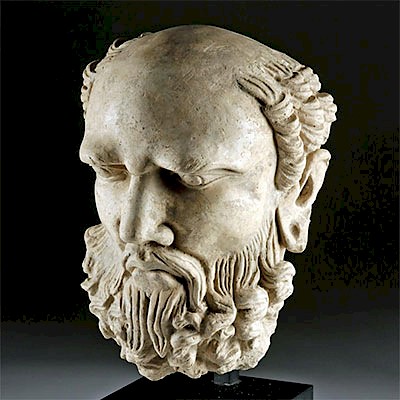Exhibited 19th C. Russian Icon - Theotokos on Deathbed
Lot 335
About Seller
Artemis Fine Arts
686 S Taylor Ave, Ste 106
Louisville, CO 80027
United States
Selling antiquities, ancient and ethnographic art online since 1993, Artemis Gallery specializes in Classical Antiquities (Egyptian, Greek, Roman, Near Eastern), Asian, Pre-Columbian, African / Tribal / Oceanographic art. Our extensive inventory includes pottery, stone, metal, wood, glass and textil...Read more
Categories
Estimate:
$8,000 - $12,000
Absentee vs Live bid
Two ways to bid:
- Leave a max absentee bid and the platform will bid on your behalf up to your maximum bid during the live auction.
- Bid live during the auction and your bids will be submitted real-time to the auctioneer.
Bid Increments
| Price | Bid Increment |
|---|---|
| $0 | $25 |
| $300 | $50 |
| $1,000 | $100 |
| $2,000 | $250 |
| $5,000 | $500 |
| $10,000 | $1,000 |
| $20,000 | $2,500 |
| $50,000 | $5,000 |
| $100,000 | $10,000 |
| $200,000 | $20,000 |
About Auction
By Artemis Fine Arts
Jan 16, 2020
Set Reminder
2020-01-16 10:00:00
2020-01-16 10:00:00
America/New_York
Bidsquare
Bidsquare : Ancient | Asian | Ethnographic
https://www.bidsquare.com/auctions/artemis-gallery/ancient-asian-ethnographic-4799
Featuring classical antiquities, ancient and ethnographic art from cultures encompassing the globe. Artemis Fine Arts info@artemisgallery.com
Featuring classical antiquities, ancient and ethnographic art from cultures encompassing the globe. Artemis Fine Arts info@artemisgallery.com
- Lot Description
Russia, ca. 19th c. CE. A heart-wrenching depiction of the Dormition of the Virgin showing the Theotokos on her deathbed, surrounded by mourning Apostles. Christ is above, looking at his mother, and holding a small swaddled child who represents the soul of the Virgin Mary. An elaborate haloed and cross-adorned coffin overlay comprised of white, light grey, and dark grey glass beads with larger translucent beads in a floral designs also serves to draw the viewer's focus on the Virgin. Size: 22.5" W x 27.25" H (57.2 cm x 69.2 cm)
Donning golden garments, with a glistening mandorla surrounding him, Jesus is presented in divine glory. The apostles are depicted standing before columns (representing Mary's house and the Temple of Jerusalem, the destination of the procession) in two clusters, this presentation reminiscent of dramatic Byzantine compositions, with their postures and gestures directing our attention toward Mary. The Dormition of the Virgin is among the most important feast days of the Eastern Orthodox Church. Commemorating the Virgin’s death or “falling asleep” and her resurrection prior to being taken to heaven, it is celebrated on August 15th. This is a fine example of the icon of the feast.
The story behind this iconography is as follows. On one of the many occasions when the Virgin was praying at Golgotha, the Archangel Gabriel appeared to her and announced that her demise from this life to eternal life was fast approaching, and she prayed that the Lord would have the apostles come see her again, and she prepared for her deathbed. Then the apostles were carried miraculously from their locales of preaching to Jerusalem where they gathered together to mourn with Christ appearing behind the coffin carrying his mother’s soul. In the words of Theodore the Studite, “ You fell asleep, yes, but not to die. You were assumed into heaven, but you never cease to protect humanity.” (Alfredo Tradigo, “Icons and Saints of the Eastern Orthodox Church” The Getty Museum (2004) p. 153)
Exhibited in "Windows Into Heaven: Russian Icons from the Lilly and Francis Robicsek Collection of Religious Art" at the Mint Museum of Art, Charlotte, North Carolina (December 20, 2003 through February 22, 2004) which presented highlights of one of the world's great artistic traditions through an extraordinary group of sixty-five 18th and 19th century Russian icons on loan from the private collection of Lilly and Francis Robicsek.
Icons (icon means "image" in Greek) are sacred objects within the Eastern Orthodox Christian tradition. Found in homes as well as churches, these painted images depict holy persons and saints as well as illustrate scenes from the Scriptures. Some icons are encased in precious metal covers (oklads) adorned with pearls and semi-precious stones or glass-fronted wooden cases (kiots). Icons are not worshiped, but are instead venerated for their ability to focus the power of an individual's prayer to God. As such they are truly "windows into heaven."
The “Windows Into Heaven” exhibition profiled a magnificent chapter of Russian artistry, the embrace of the Russian Orthodox faith of religious icons during the Romanov centuries. The Russian religious faith was an offshoot of Byzantine Christianity, which in 1054 parted ways from Roman Catholicism. Icons were and continue to be religious images created for veneration. As a focus for prayers and meditation for believers, icons serve as “windows into heaven.”
Provenance: private Francis & Lilly Robicsek Collection, Charlotte, North Carolina, USA, acquired second half of the 20th century; exhibited at Mint Museum of Art "Windows Into Heaven", Charlotte, North Carolina, USA (December 20, 2003 through February 22, 2004)
All items legal to buy/sell under U.S. Statute covering cultural patrimony Code 2600, CHAPTER 14, and are guaranteed to be as described or your money back.
A Certificate of Authenticity will accompany all winning bids.
We ship worldwide and handle all shipping in-house for your convenience.
#119605Stable age cracks and losses to pigment/gold leaf as shown. Abrasions and losses to peripheries as shown. Mint Museum label and old inventory label on verso. Back slats intact. Suspension wire on verso.Condition
- Shipping Info
-
All shipping is handled in-house for your convenience. Your invoice from Artemis Gallery will include shipping calculation instructions. If in doubt, please inquire BEFORE bidding for estimated shipping costs for individual items.
-
- Buyer's Premium



 EUR
EUR CAD
CAD AUD
AUD GBP
GBP MXN
MXN HKD
HKD CNY
CNY MYR
MYR SEK
SEK SGD
SGD CHF
CHF THB
THB




















